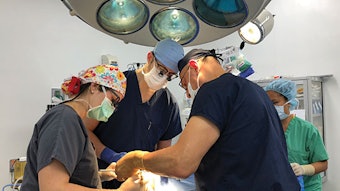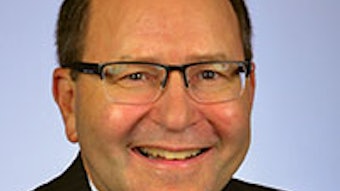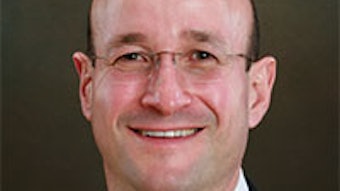From the AAO-HNSF PSQI Committee – Wrong site surgery: A never event
A 20-year-old was found to have a profound sensorineural hearing loss in her right ear and aidable sensorineural hearing loss in her left ear on audiogram. Based on testing, she was deemed a cochlear implant candidate in the right ear and was scheduled for surgery. CT imaging showed normal temporal bones. One month later, she went to the OR for cochlear implantation.
Heather M. Weinreich, MD, MPH, Department of Otolaryngology-Head and Neck Surgery, University of Illinois-Chicago, Chicago, IL; and Emily F. Boss, MD, MPH, Department of Otolaryngology-Head and Neck Surgery, Johns Hopkins University, Baltimore, MD
True event:

A 20-year-old was found to have a profound sensorineural hearing loss in her right ear and aidable sensorineural hearing loss in her left ear on audiogram. Based on testing, she was deemed a cochlear implant candidate in the right ear and was scheduled for surgery. CT imaging showed normal temporal bones. One month later, she went to the OR for cochlear implantation. The mastoid and facial recesses were drilled without issue. A round window approach was performed, and the electrode was passed with some resistance. Due to the resistance, the surgeon called for an intra-operative plain film to check placement. As the surgeon was explaining the situation to the radiology technician, the OR team realized that the LEFT ear had been implanted.
“Wrong site surgery” is any surgery performed on the wrong part or side of the body. The Centers for Medicare & Medicaid Services (CMS) considers it a sentinel or “never event.”1 Wrong site surgery is one of the most common events reported to the Joint Commission, second only to falls and retained foreign bodies, with 95 cases reported in 2017.2 Orthopedic procedures make up the greatest percentage of cases (36 percent) followed by gynecology and plastic surgery.3 Within otolaryngology, wrong site surgery has been estimated to be as high as 6.1 percent4 and accounts for 4.4 percent of otology legal claims.5 Between 9 percent and 21 percent of otolaryngologists will report experience with wrong site surgery during their career.5
A wrong site surgery in otolaryngology rarely results in permanent disability or death. However, significant consequences like operating on a hearing ear (e.g., cochlear implant) can lead to permanent loss that is detrimental to the patient. In a study of the United Kingdom’s National Health Service, wrong site surgery was cited as a basis for 11 successful litigation claims, with an average payout of £78 000 (~ US $108,725).6 Many state medical boards have enacted significant penalties to surgeons in an effort to protect the public.
Wrong site surgery generally occurs due to systems-based issues and not solely due to error in clinician judgment. More commonly it is a consequence of the swiss cheese model of error, where multiple holes at various steps line up for the adverse event to occur.7 Not documenting the correct ear during the clinic visit, a failure to review the audiogram, a CT scan with incorrectly labeled laterality, or a pre-operative mark that rubs off during prep all can lead to operation on the wrong ear.
In analysis of United States claims data from 2010-2014, the following reasons for wrong site surgery were cited.3
- Incorrect body site selected
- Policy or protocol not followed
- Inconsistent documentation
- Failure to read medical record
- Misidentification of anatomical structure
- Inaccurate documentation
- Lack of policy
- Misinterpretation of diagnostic studies
- Information lost in transition
- Inadequate history and physical
- Distraction
- Multitasking or interruptions
Of reported cases to the Joint Commission over an eight-year period, leadership (culture, lack of procedures and policies, failure to follow procedures and policies), communication, and human error make up the top three etiologies for wrong site surgery.7 Within otolaryngology, Shah, et. al. reported that inverted imaging made up almost 50 percent of wrong site sinus surgeries.8
Given that wrong site surgery occurs due to multiple missteps, a multi-faceted approach is essential to prevent errors. Several organizations have mandated the use of protocols to prevent wrong site surgery. In 2004, the Joint Commission mandated the use of Universal Protocol, which includes:
- Following a pre-procedure verification process
- Marking the operative site
- Taking a time-out immediately before starting the procedure
- Adapting requirements for non-OR settings, including bedside procedures
However, data has been mixed on the effectiveness of the program.5
CMS has implemented a program for ambulatory surgery centers that encourages the use of a safe surgery checklist. Checklists have been shown to be effective9,10 and can be implemented at any point from the time the patient is examined in the clinic to the moment the scalpel touches skin.
Marking is a simple process and has become a standard procedure. What should be stressed is that the person performing the surgery performs the marking and, more important, verbally confirms with the patient and reviews the side documented on the written consent. In addition, the mark should be visible after prepping and, as a time-out is performed, all in the room (nursing, anesthesia, scrub, surgical team) can verify its presence. However, in many otolaryngology procedures, marking isn’t possible (e.g., oropharynx). In these circumstances, marking on paper diagrams in pre-op and attaching these to consent for verification during time-out can be utilized.
Time-outs are an effective tool. As an intern on an anesthesiology rotation, one author of this article personally witnessed the power of a time-out. In a scheduled thoracentesis, a resident, OR nurse, and scrub had prepped and draped the wrong side. During the time-out, the correct site was identified and confirmed with radiographic imaging. They watched as a shaken and humbled cardiothoracic attending sat down, whispering, “The time-out worked … we almost operated on the wrong side.”
At minimum, the patient’s name and birth date, procedure, and side of procedure should be confirmed. In the OR, the surgeon should verify imaging and supporting tests (e.g., audiogram) to confirm side. Additionally, during the time-out, no phone calls or pages should be taken. All individuals in the OR should be paying attention, and shift changes should not occur during this time. This time-out is one of the last checks before damage can happen. Staff education and creating a culture of safety does work to reduce error.11
Despite the positive influence of checklists, marking, and time-outs, such protocols fail to address the upstream root causes of poor documentation, misinterpretation of diagnostic studies, inadequate history and physical examinations, and the mere fact that surgeons are forced to practice in environments where they are incentivized to see more patients in less time with less support. We should catch the issue before the patient is in pre-op or on the table. Although surgery is a team approach, we as the surgeons need to take the lead. We create the relationship, evaluate the patient in the clinic, and facilitate decisions on surgical treatment that we then perform. Therefore, it is the surgeon’s responsibility to create and lead a culture of safety. All the while, as surgeons, we should maintain a healthy dose of skepticism. Is it the correct side?
- CMS. Decision Memo for Surgery on the Wrong Body Part (CAG-00402N). https://www.cms.gov/medicare-coverage-database/details/nca-decision-memo.aspx?NCAId=222&NcaName=Surgery+on+the+Wrong+Body+Part&DocID=cag=00402N. January 15, 2009. Last accessed 4/25/18.
- The Joint Commission. Sentinel Event Data Summary. https://www.jointcommission.org/assets/1/18/Summary_4Q_2017.pdf. Updated February 23, 2018. Last accessed 4/25/18.
- The Doctors Company – Closed Claims. 2010-2014. https://www.thedoctors.com. Last accessed April 26, 2018.
- Shah RK, et al. Classification and consequences of errors in otolaryngology. Laryngoscope. 2004 Aug;114(8):1322-35.
- Liou TN, Nussenbaum B. Wrong site surgery in otolaryngology-head and neck surgery. Laryngoscope. 2014 Jan;124(1):104-9. doi: 10.1002/lary.24140. Epub 2013 May 13.
- Metcalfe CW, Muzaffar SJ, Coulson CJ. Litigation trends and costs in otorhinolaryngology. J Laryngol Otol. 2015 Oct;129(10):941-4.
- Reason J. Human error: models and management. BMJ. 2000 Mar 18;320(7237):768-70.
- Shah RK, Nussenbaum B, Kienstra M, et al. Wrong-site sinus surgery in otolaryngology. Otolaryngol Head Neck Surg 2010;143:37–41.
- Haynes AB, Weiser TG, Berry WR, et al. A surgical safety checklist to reduce morbidity and mortality in a global population. N Engl J Med. 2009;360:491–499.44.
- De Vries EN, Prins HA, Crolla RM, et al. Effect of a comprehensive surgical safety system on patient outcomes. NEJM 2010;363:1928–19.
- Algie CM, Mahar RK, Wasiak J, Batty L, Gruen RL, Mahar PD. Interventions for reducing wrong-site surgery and invasive clinical procedures. Cochrane Database Syst Rev. 2015 Mar 30;(3):CD009404. doi: 10.1002/14651858.CD009404.pub3. Review.
















